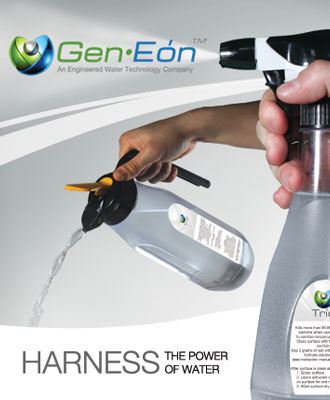GENEON® TECHNOLOGIES’CHEMICAL FREE CLEANING AND SANTIZING PERFORMANCE CONFIRMED BY MULTIPLE THIRD-PARTY LABORATORIES

Company’s Sustainable Solution Thoroughly Tested for Dirt Removal, Germ Kill
SAN ANTONIO, TX. — October 16, 2012 — GenEon Technologies today announced the results from a battery of tests performed by third-party laboratories and universities on its new cleaning and sanitizing device, the Trio®. The independent results confirm that the dirt-removal and germ-killing performance of the GenEon chemical-free technology is equal to or better than traditional chemicals by common measures of efficiency, effectiveness, and expense.
“Today’s test results affirm what has long been known about the solution produced by GenEon’s proprietary technology. Namely that it is an excellent chemical-free cleaner and degreaser,” said John Shanahan, co-founder and vice-president of sales for GenEon Technologies.
“Overall, the Trio removed over 91% of the bathroom soil on all substrates,” reports the Toxics Use Reduction Institute’s Surface Solutions Laboratory (TURI) at the University of Massachusetts, Lowell, on independent testing done on common bathroom soils. The report concludes, “The Trio had an overall efficiency of over 85% and performed as well as common green and conventional cleaners.” For a copy of this report, please contact GenEon.
The GenEon Trio is a patented, proprietary cleaning technology with a precious metal at its core designed to conduct an electrical charge across a mixture of water and minerals. After energizing, a naturally-occurring cleaner and degreaser are created onsite and on-demand. This solution can then be used to clean a multitude of surfaces and soils without the aid of traditional and toxic chemicals.
An added bonus of the GenEon system is that it can also produce a sanitizing solution called hypochlorous (HOCl) to kill germs. Independent tests confirm the GenEon solution kills up to 99.999% of the most common germs in less than 30 seconds when used as directed. For a copy of the report and a complete list of the germs, please contact GenEon.
The science behind the creation of hypochlorous is not new—nor is it complex. Food processing plants, technology clean rooms, and organic grocers long ago abandoned toxic cleaning chemicals in favor of naturally occurring hypochlorous as a means to cleaning and sanitizing food prep areas, fruits and vegetables, and highly sensitive clean rooms. These industries virtually invented the process of energizing water and minerals to create inexpensive, sustainable, highly effective cleaning and sanitizing solutions. GenEon Technologies simply reduced the size of these machines, making them accessible for everyday use.
“Hypochlorous is very safe,” notes Shanahan. “So safe, in fact, the human body produces it in white blood cells to fight off infection.” (For scientific support of this claim, please contact GenEon.) Though the solution carries a fresh, bleach-like smell, it is actually a distant cousin to the common cleaning chemical, with the scent originating from the chlorine. Technically, hypochlorous in this form contains “free available chlorine;” harmful to dirt and germs, but safe on skin and clothing.
In the 1980s, the United States EPA recognized hypochlorous as 80 times more effective than bleach, but safe enough to be certified GRAS (Generally Recognized As Safe) by the FDA. In a 2008 report to the public on the properties of hypochlorous, the U.S. CDC notes: “The microbicidal activity of a new disinfectant, ‘superoxidized water,’ has been examined. The concept of electrolyzing saline to create a disinfectant or antiseptics is appealing because the basic materials of saline and electricity are inexpensive and the end product does not damage the environment. The main products of this water are hypochlorous and chlorine. As with any germicide, the antimicrobial activity of superoxidized water is strongly affected by the concentration of the active ingredient (available free chlorine). The solution is non-toxic to biologic tissues. In 2002, the FDA cleared superoxidized water to be a powerful disinfectant.” For a copy of this report, please contact GenEon. .
Rick Kowsky, owner of Cascade Ambulance in Ferndale, Washington switched from traditional chemicals to GenEon Technologies to clean his fleet of emergency vehicles in a cheaper, safer method. “It’s as simple as water and salt and it’s virtually painless to use,” he notes. “We love it.”
“Best of all,” Shanahan notes, “Creating hypochlorous onsite eliminates the ongoing expense of purchasing sanitizing chemicals. Repeatedly buying chemicals is exchanged in favor of repeat creations of hypochlorous. It’s a win-win for everyone.”
GenEon Technologies will be demonstrating its sustainable system for cleaning, degreasing, and sanitizing at the 2012 International Sanitary Suppliers Association expo and conference at the McCormick Place Convention Center in Chicago, IL, October 17—19, 2012. GenEon will be in booth #126. For copies of the test reports cited in this release or for more information, please visit www.geneontechnologies.com.
GenEon Technologies is a privately held U.S. technology corporation based in San Antonio Texas. The company is committed to engineering water for more sustainable living. A multinational corporation that operates with a focus on diversity, as well as renewable environmental management systems, GenEon and its patented technology provides an alternative to cleaning the places people live, work, and play every day without the use of traditional, toxic cleaning chemicals. Addressing the ever-growing need for sustainable cleaning, GenEon’s super oxidized water technology solutions are ideal for restaurants, hotels, hospitals, schools and private residences. For more information, visit www.geneontechnologies.com, and follow GenEon on Facebook/Geneontechnologies, or Twitter @geneon Copyright 2012 GenEon Technologies, Inc.
Patents pending, GenEon Technologies.
# # #
CONTACT:
John Shanahan
815.288.1743
John.shanahan@geneontechnologies.com
Tags:



